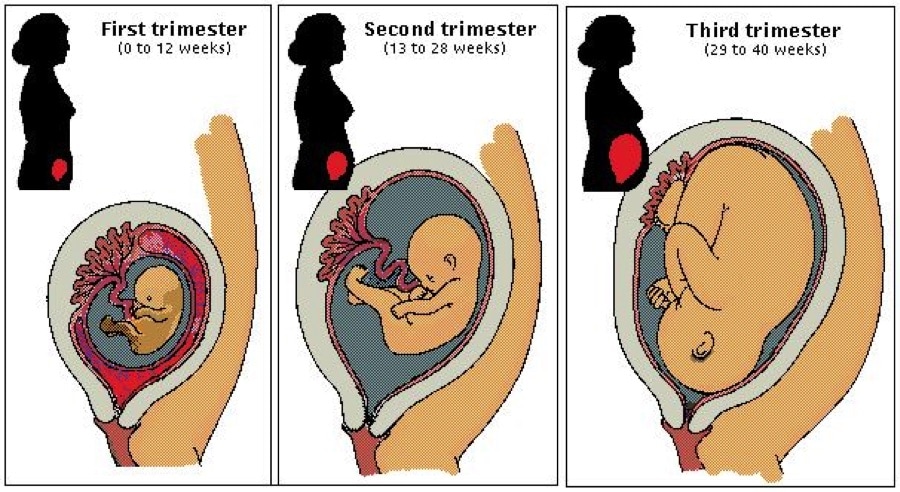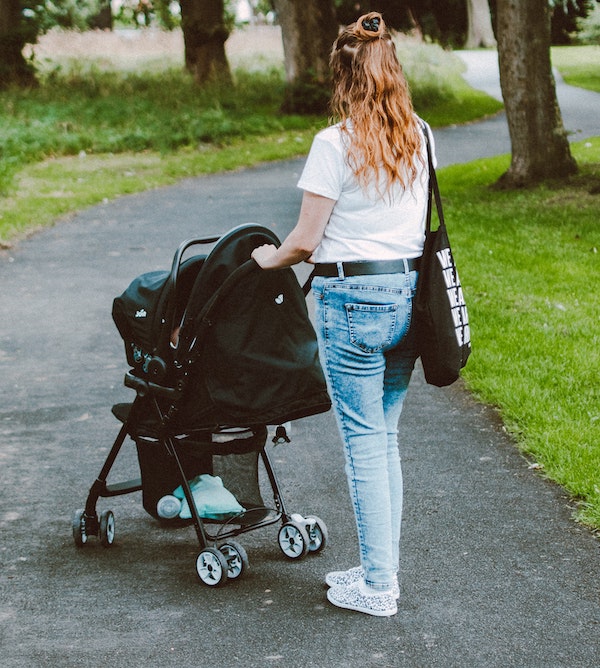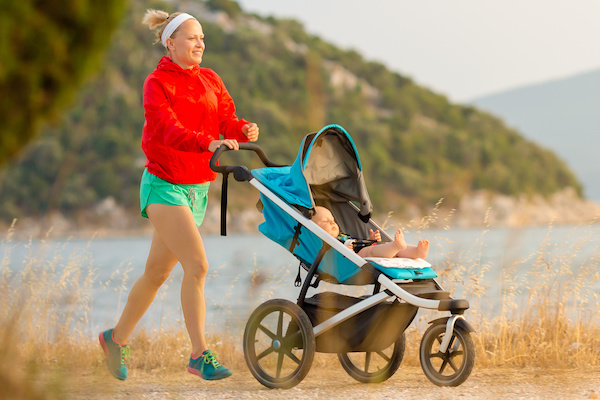After giving birth, your body enters another very busy phase known as the postpartum period. This stage is characterized by physical, physiological, mental, and behavioral changes as the body tries to recuperate from the 9 difficult months of supporting the growth of the baby and bringing it to the world.
It’s also associated with complications and disorders including insomnia, excessive fatigue, incontinence, and postpartum blues and depression.
These changes and complications will have a toll on the mother’s health and wellbeing. It could also impact on her ability to care for the baby and interact with others.
While what she requires most at this stage is physical, social and emotional support, there is mounting evidence that physical exercise greatly improves the quality of life postpartum.
Breaking a sweat soon after childbirth relieves stress and fatigue, boosts your energy levels, helps you sleep better, and could also stave off postpartum depression.
Of course, no 2 pregnancies are the same- and this means that different moms will require varying types of exercises depending on their exact needs.
Ultimately, physical activities after giving birth need to be safe and effective and should not be a threat to your stitches and tears.
When Can You Resume Exercises After Vaginal Delivery?
Moms who were physically active before and during pregnancy- and pretty much anyone else who is itching to have her pre-baby body- wonder how soon they can begin working out.
A few decades ago, postpartum mothers were advised to stay put for at least 6 weeks before beginning any form of exercise.
But the American College of Obstetricians and Gynecologists now say that you can start exercising soon after birth so long as you had a healthy pregnancy and an uncomplicated vaginal delivery.
Of course, you don’t have to get to exercises right away if you don’t feel ready yet. A key pointer here is how you feel and the amount of energy in you.
| It’s crucial that you get an all-clear from your healthcare provider first more so if you had any form of complications. |
What About Cesarean Section?
Cesarean section is a major surgery that involves cutting the abdominal muscles and then suturing the cut.
Experts recommend being extra careful not to exert a lot of pressure on these muscles soon after birth for a smooth healing process. Too much strain could lead to complications including incisional hernia and delayed healing. It could also cause the wound to come apart at worse.
Generally, it takes 6 to 8 weeks for a C-section wound to heal completely with good care. To be on the safer side, though, you might want to extend this to 10 weeks. Obstetrician gynecologists, however, say that you can start some light exercises as soon as 6 weeks provided you are keen at it and you are listening to your body. Don’t forget to check this with your doctor!
Signs That Your Body Is Not Ready For Exercises Yet
No matter how good and fit you feel, ensure that you have your doctor’s approval before jumping into any form of postpartum exercise.
Pushing yourself too much post-baby may actually lead to more injuries or prolong the healing process. This only leads to more frustrations both physically and mentally.
Besides telling you whether or not your body is ready, your doctor will also be in a position to advise you on the best postpartum exercises to try out.
Here are key warning signs that you need to give your body some more time to recover:
- Pelvic pain during sexual intercourse – be keen to read any other pain around your pelvic floor.
- Diastasis recti – this is a gap that develops between your abdominal muscles (‘6 pack muscles’) around your belly button during pregnancy. This gap is usually 1-2-finger width and may or may not close postpartum. There are no short-term or long-term problems to fear. However, in case this gap is wider the 2-finger widths, it’s important that you consult with your health practitioner first.
- Bleeding restarts long after thinking that it had disappeared.
- Any kind of pain (joint, pain, or muscle) that can be linked to birth and which occurs every time you exercise.
- A feeling of a heavy pelvic floor – this could be pelvic organ prolapse and feels like something is on its way out from the inside.
- Urinary leakage
- Low back pain
- Instability
Most of these conditions are common after giving birth, but they can be easily aggravated with intense exercises. Some of them especially unexplained bleeding, pelvic pain, and a heavy feeling on the pelvic require a health expert’s attention ASAP. If you experience any of these problems or have other health concerns contact your doctor immediately.
Benefits Of Exercises In Postpartum Women
When your body is ready, everything healed properly, and your doctor allows you to start exercising, physical activity may have a lot of benefits for your well-being. Of course it’s best to consult exercising not only with your doctor, but also with postnatal physiotherapist and postnatal personal trainer.
Stabilizing And Boosting Your Mood
Drastic hormonal changes coupled with other parental worries following delivery may lead to symptoms of depression including mood swings.
While there are different ways of managing stress and mood swings, engaging in some physical activities is often cited as the most effective but underused method.
Recent study shows a direct link between physical activities and elevated mood among 1.2 Americans. Psychiatrists say that exercises boost the production of endorphins. These are chemicals that enhance your wellbeing and feeling of satisfaction by minimizing the perception of pain and helping you relax.
Importantly, exercising also reduces the activity of cortisol and adrenaline hormones that create feelings of stress and anxiety and tension respectively.
Melt Off Your Post-Baby Pounds & Tone Your Body
Giving birth changes your body in a whole lot of ways including adding weight. According to the American College of Obstetricians and Gynecologists, a woman of average weight gains 25-35 pounds during pregnancy.
While you’ll melt off most of these pounds once you start breastfeeding, some are for keeps unless you decide to torch them.
There’s no easier way to blast those won’t-budge calories than with regular exercises. Regular workouts minimize the number of calories that are stored as fat and also helps you hold onto your newly thin figure.
Also, exercising reduces stress and might, therefore, help curb emotional eating if you are among those who eat a lot when stressed.

Helps Get Rid Of Common Pain & Aches
Giving birth is painful whether you have a natural delivery, an assisted one, or C-Section. But the truth is that you might experience other pains and aches even after delivery albeit not as much as the actual childbirth pain.
For instance, you might feel some contractions (again?!) as your uterus contracts to its pre-pregnancy state. These pains are akin to menstrual cramps and they tend to get more pronounced when breastfeeding.
Most women also experience difficulties with bowel movement. Postpartum constipation may be as a result of the medication used to stave off pains.
It can also be psychological and it’s caused by fears of putting more strain on the episiotomy stitches which could lead to more pain.
Exercises help in easing constipation in 2 ways:
- It limits the amount of time that food takes in the gastrointestinal tract. This lowers the amount of water that is absorbed back from the stool. Since poop is no longer hard, it becomes easy to pass
- Aerobic exercises elevate your breathing and heart rate. This stimulates the natural movement of your intestinal muscles and thereby helps poop move out quickly
Two-thirds of postpartum women also experience pelvic floor pains coupled with other problems including wee stress incontinence, wind, and fecal incontinence (rare but possible).
Pelvic floor pains are mostly as a result of badly weakened muscles. If not taken care of early enough, these muscles are likely to develop problems later in life.
The good news is that Kegel exercises and physical therapy can help rebuild these muscles and prevent incontinence.
Gets You Back In Control
Motherhood is a full-time and extremely taxing job constantly revolving around diaper changes, breast and bottle feeding, dinner, sleepless nights and sore backs.
Whether you are a new or experienced mom, it’s very easy to lose yourself and slowly fade away from things that positively affect your personal growth including passions and hobbies.
In so doing, we forget the most important rule in life: self-preservation comes first. And the result is that we work so hard to deliver the best care but we can’t since we are not at our best in the first place.
Postpartum workouts reconnect you to your former self and also gives you the feeling of being in good control of everything around you.
Workouts allow you to recentre yourself and start focusing on things that make you even better. This is because exercises not only impact your physical strength but your mental strength too.
Postpartum Exercises Safety Concerns: Possible Risks
During pregnancy, the enlarging uterus and growing fetus have a significant impact on the position and function of your inner core.

As the fetus grows, it pushes upwards thereby restricting the diaphragm, downwards straining and weakening the pelvic floor, and outwards against the abdominal wall (this is what causes diastasis recti, remember?).
These drastic changes have a toll on how these muscles function. This puts a woman susceptible to complications such as incontinence, pain, and pelvic organ prolapse.
Good news, the body naturally recovers from this pre-pregnancy physique in around 4-6 weeks. Unfortunately, this process may take longer for some women.
Also, the recovery process may stall before the inner core muscles have fully recovered their strength and function. This leaves the mother more susceptible to injuries and low back pains. Inappropriate postnatal physical exercises may aggravate or trigger issues including pelvic floor dysfunction.
How To Know Whether Your Inner Core Is Ready For Regular Postpartum Exercises?
The muscles of the inner core work in coordination; when you inhale, the diaphragm muscles expand and push the organs down. This creates pressure in the abdomen and the pelvic floor responds by relaxing. When you exhale, the pelvic floor contracts and moves in.
This coordination can break due to pain, surgery, childbirth, and trauma among other things.
It’s somewhat hard to self-assess whether your inner core muscles are working in coordination and optimally. It’s even much harder to self-examine the condition of the pelvic floor since its muscles have fewer sensory nerves.
The surefire way around this is booking an appointment with a trained Pelvic Health Physiotherapist. But women don’t consider this necessary.
So, here are steps to know if your pelvic floor is ready for postpartum exercises:
- Ensure that you don’t have any of the signs that suggest that your body isn’t ready for exercises yet
- Listen to your body – if you feel that jumping may cause some pain or leaks, you are probably correct
- Always start slow regardless of how strong and confident you feel
- Increase the level and intensity of the exercises while being keen on any warning signs
- In case of any red alert or concerns back off and consult your doctor first
Safety Tips When Resuming Postpartum Exercise Routine
Your body has just undergone tremendous changes. This means that resuming your old fitness routines might not be as easy as you think.
In addition to working closely with your doctor, here are the key steps to scaling back to your active life safely;
Patience Pays Off
It took a good 39 weeks (give or take) for your body to transform to its current state. Pushing it too hard to revert the changes in a week is not possible. If anything, it might cause more problems or aggravate the existing ones.
Start Slowly
No matter how good you feel, your body might not be ready for full-blown workouts yet. Walking for a few minutes is a good start. You can build up from here once you are sure that there is no bleeding or pains.
Be Keen On Any Red Flags
Be sure to listen to your body and keep off if something doesn’t seem right. Don’t ignore even the slightest pain or bleeding especially from your lower abdomen.
Consider Your Pelvic Floor
Pregnancy weakens the pelvic floor a great deal. Inappropriate postpartum exercises may put too much pressure on it thereby weakening it further or even causing pelvic organ prolapse. So, once your doctor clears you to exercise postpartum, consider physical activities such as Kegel that strengthen these floors first (more about this below).
Stay Hydrated
It might sound counterintuitive but drinking lots of water after pregnancy helps in losing water weight. It also helps in pushing waste products out through the kidney thereby speeding up the recovery process.
Rest Up
Getting enough rest is another great way of treating yourself. Sufficient sleep and rest will make you more productive and also keeps you healthy and happy.
Best Exercises To Do After Birth
While your body may be ready to take in some exercises 6 weeks postpartum, it’s not ready for kickboxing and swimming yet.
Here are simple and functional physical activities to kick you off:
Walking
If your doctor doesn’t order you to lay down, walking may be a good start to physical activity after giving birth. Especially walking with the stroller is highly recommended for postpartum moms as it does not put a lot of pressure on the pelvis. Walking outside gives you a few minutes of fresh air in addition to gently activating your core muscles. Besides, it is a great way to bond with your baby.

Once your baby develops good neck and head control (around 6-8 month), and your body feels fine, you may even start jogging with a stroller. Of course you should consult this with your pediatrician first, and choose proper jogging stroller.
Kegels
These exercises are essential for strengthening your pelvic floor. They are very important for strengthening the muscles that support the uterus, bladder, and bowels, as well as vaginal muscles, which may be weakened after the pregnancy and delivery. These exercises promote perineal healing and help you regain bladder control. Actually, Kegel exercises are recommended for women not only after the delivery, but also before and during pregnancy as they may help with problems with bladder control and hemorrhoids.
Diaphragmatic Breathing
This is a gentle ab workout and it also promotes relaxation by lowering the level of the stress hormone cortisol in your system. This type of breathing also lowers your heart rate and blood pressure thereby minimizing anxiety.
Impacts Of Postpartum Physical Activity – Scientific Findings
A lot of studies have been conducted to determine the sensibleness of postpartum exercises on the general wellbeing of the mother and child.
Impacts On Quality Of Life
In one study, the researchers wanted to evaluate the effects of physical activities on the postpartum quality of life physically, mentally, and socially.
The participants were 62 women giving birth for the first, second, or third time and they all underwent normal vaginal delivery.
Postpartum wellbeing was measured using the SF-36 life quality questionnaire – one of the most trusted tools for this purpose.
Here are the general findings of the study:
- The general observation was that physically active postpartum moms have better general wellbeing
- Active moms are less susceptible to retain weight
- They find it easy to adjust to life after pregnancy
- They are more likely to engage in recreational activities
- Physically active postpartum moms have better relationships with their husbands, family members, and friends
- They also score highly on mental wellbeing tests
- Another study cited by these researchers show that active women who undergo normal vaginal delivery score higher marks in terms of social performance compared to the C-section group
- Exercises improve the physical wellbeing of postpartum women especially if expert guidelines are adhered to
Impacts On Weight Loss
In another article published in the International Journal of Obesity, the researchers wanted to determine the impacts of physical exercise strategies and interventions on weight loss.
This study consisted of 769 participants who were divided into 5 categories. The first group was of participants who had goals based on pedometer (number of steps walked) and/or heart rate targets.
Participants in the second group based their goals on time (number of days or duration of exercise), or distance, for instance covering 5 kilometers per day.
The third group did not have a specific goal when exercising. The fourth group was an analysis of previous studies and it involved comparing the results depending on the level and type of intervention, for instance, calorie restriction or counseling.
Here are the findings of this study:
- The general observation was that randomized intervention on physical activities had a significant impact on weight loss with or without dietary restrictions
- Physical activities that used pedometer and heart rate targets as goals were much more effective compared to other types of goals
- Combining postpartum exercises with intensive dietary changes and close monitoring has the greatest impact
- A study cited by the researchers found that walking, resistance, and moderate energy restriction are safe weight loss methods
Benefits Of Jogging With A Stroller
You probably own or are planning to own one: a jogging stroller. These strollers are aptly named so since they are meant to allow you to jog while pushing the baby in front of you. But what are the real benefits of this?

Well, researchers from the University of Tennesse and Michigan State University wanted to find out this in a study titled “Physiologic Responses to Running with a Jogging Stroller”.
This study aimed at determining the effects of stroller jogging on oxygen consumption, heart rate, and rating of perceived exertion.
It consisted of 2 groups of participants. The first group had 15 members who ran on an indoor track. The second group had 12 participants running on an urban paved greenway.
Each of the participants completed 6 one-mile trials. Of the 6 trials, the participants ran 3 of them at a pre-determined pace while the rest 3 were self-paced.
The general findings for the study were as follows:
- There is a significantly notable difference in oxygen consumption and rating of perceived exertion between jogging with and without a stroller
- Pushing a stroller on rough surfaces leads to a greater oxygen consumption than pushing the same stroller on smoother surfaces
- Jogging with a stroller on outdoor greenways causes a notably higher oxygen expenditure
In conclusion, the researchers add that postpartum parents can maintain a healthy lifestyle and meet their personal fitness goals using a jogging stroller.
They also note that the major benefit here is being able to overcome typical barriers that prevent parents with young children from being physically active.
Also, a jogging stroller makes it possible to stay active while addressing the needs of the baby and introducing them to a healthy and active lifestyle.
Impact Of Postpartum Physical Activity On Breastfeeding & Infant Development
There have been concerns and lots of contraindications about the effect postpartum exercises on milk supply, mineral concentration, and acceptability by the baby.
A highly publicized 1992 study claimed that babies tend to fuss and refuse breastmilk when moms exercised at 100% intensity. However, these findings have been highly criticized since the babies were fed using a dropper- an unfamiliar method to the babies at that time.
Contrary to these findings, a 2002 study shows that both moderate and acute exercises don’t affect babies’ acceptance of milk 1 hour post exercise.
Several other studies have been done to assess whether exercises affect the composition of breastmilk.
In one such study, 100% intensity exercises were found to cause a slight increase in lactic acid in breastmilk for around 90 minutes. However, moderate exercises- that most postpartum moms are more likely to engage in- did not show any noticeable increase in lactic acid.
If anything, no study has found a harmful effect of this acid on the baby.
Other research findings published in The American Journal of Clinical Nutrition show that even at maximum intensity, postpartum physical activities don’t alter the concentration of major breastmilk components: magnesium, calcium, potassium, and sodium.
Lastly, data from another study titled “Exercise and Lactation: are they compatible” show that exercises don’t have any detrimental effect on milk supply and composition and infant growth and development.
Bibliography:
American College of Obstetricians and Gynecologists. “Frequently asked questions labor, delivery and postpartum care.” (2013): 15-05.
Bahadoran, B., et al. “Evaluating the effect of exercise on the postpartum quality of life.” Iranian Journal of Nursing and Midwifery Research 12.1 (2007): 17-20.
Carey, Gale B., and Timothy J. Quinn. “Exercise and lactation: are they compatible?.” Canadian journal of applied physiology 26.1 (2001): 55-74.
Chekroud, Sammi R., et al. “Association between physical exercise and mental health in 1· 2 million individuals in the USA between 2011 and 2015: a cross-sectional study.” The lancet psychiatry 5.9 (2018): 739-746.
Fly, Alyce D., Katherine L. Uhlin, and Janet P. Wallace. “Major mineral concentrations in human milk do not change after maximal exercise testing.” The American journal of clinical nutrition 68.2 (1998): 345-349.
Gregory, D. A., et al. “Physiologic responses to running with a jogging stroller.” International journal of sports medicine 33.09 (2012): 711-715.
Nascimento, S. L., et al. “The effect of physical exercise strategies on weight loss in postpartum women: a systematic review and meta-analysis.” International Journal of Obesity 1 (2013): 1-10.
Quinn, Timothy J., and Gale B. Carey. “Does exercise intensity or diet influence lactic acid accumulation in breast milk?.” Medicine and science in sports and exercise 31.1 (1999): 105-110.
Wright, Kc S., Timothy J. Quinn, and Gale B. Carey. “Infant acceptance of breast milk after maternal exercise.” Pediatrics 109.4 (2002): 585-589.
The purpose of this article is only informative. Please keep in mind that this article IS NOT a medical advice and it’s not a substitute for consultation with a doctor. Always consult your postpartum activity, exercises, health concerns and decisions with medical professionals (like your GP, gynecologist, midwife, postnatal physiotherapist, as well as postnatal personal trainer). Remember: safety first! Physical activity after pregnancy may be enjoyable and beneficial for you, only if done properly and when your body is ready.

